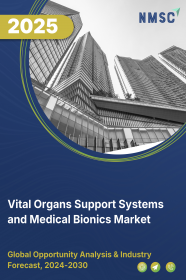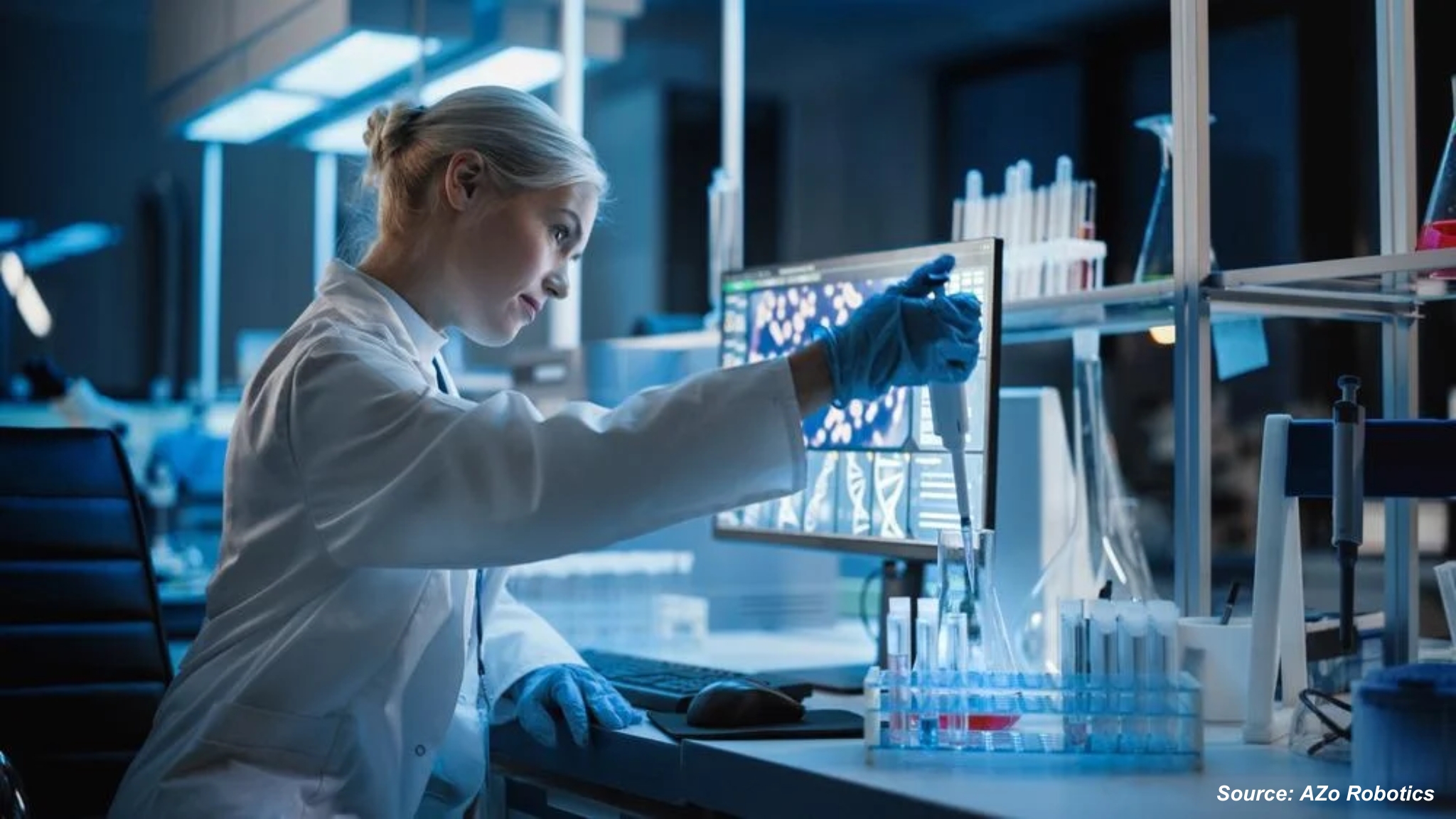
Vital Organs Support Systems and Medical Bionics Market by Vital Organ Support Systems (Artificial Heart, Artificial Kidney, Artificial Pancreas, Artificial Urinary Bladder, Artificial Lungs, and Artificial Liver), by Medical Bionics (Bionic Eye, Ear Bionics, Orthopedic Bionics, Cardiac Bionics, and Neural Bionics), by End User (Hospitals, Ambulatory Surgical Centers, and Others) - Global Opportunity Analysis and Industry Forecast, 2020 – 2030
Market Definition:
The global Vital Organs Support Systems and Medical Bionics Market size was valued at USD 33.88 billion in 2019 and is predicted to reach USD 93.80 billion by 2030, with a CAGR of 9.7% from 2020-2030.
The Organ Support System comprises of artificial organs that are designed to perform the function of natural human organs, and are utilized as a substitute of lost body organ, replacement of the damaged organ, and as a support to the existing organs. These artificial organs interface with live tissues and fill the void of human organs.
Medical bionics is the study of mechanical systems that replicate living organisms or parts of living organisms. The benefits offered by artificial organ support systems and medical bionics are reduced risk of organ rejection, cost-effective alternative for treating multiple diseases, and lowering the dependency on human donors. These benefits are expected to supplement the growth of vital organs support systems and medical bionics market.
Market Dynamics and Trends
The global vital organs support systems and medical bionics market observed a substantial growth in the past few years, and is expected to demonstrate a considerable elevation in terms of share and value, in coming years. This is due to lack of organ donors, increasing cases of organ transplantation, growing demand from people suffering from disability either genetic or accidental, and increasing prevalence of chronic diseases.
Moreover, factors such as constantly multiplying geriatric population, advancement in product technologies, and demand from defense & military sector, are expected to enhance the growth of global vital organs support systems and medical bionics market, throughout the forecast period.
However, high cost of the artificial devices and medical bionics, with stringent regulatory approval processes are expected to inhibit the growth of vital organs support systems and medical bionics market.
Moreover, favorable reimbursement policies, financial support provided by public and private sectors, as well as favorable healthcare coverage schemes; shall reinforce the growth of vital organs support systems and medical bionics market in coming future.
Market Segmentations and Scope of the Study:
The global vital organs support systems and medical bionics market share has been analyzed based on vital organ support systems, medical bionics, end user and geography.
Based on vital organ support systems, the market is segmented into artificial heart, artificial kidney, artificial pancreas, artificial urinary bladder, artificial lungs, and artificial liver. Based on medical bionics, the vital organs support systems and medical bionics market is fragmented into bionic eye, ear bionics, orthopedic bionics, cardiac bionics, and neural bionics. The ear bionics segment is sub segmented into cochlear implants, bone anchored hearing systems, and auditory brainstem implants. The orthopedic bionics segment is further divided into upper limb, lower limb, exoskeleton, and electrical bone growth stimulators. The Cardiac bionics segment is further sub segmented into pacemaker, ventricular assist device, and artificial heart valves. The Neural Bionics is further divided into internal neurostimulators and external neurostimulators. Based on target disease, the vital organs support systems and medical bionics market is divided into hospitals, ambulatory surgical centers, and others. Geographic breakdown and analysis of each of the previously mentioned segments include regions comprising North America, Europe, Asia-Pacific, and RoW.
Geographical Analysis
North America is expected to maintain its dominance in the global vital organs support systems and medical bionics market, owing to the presence of developed economies and increased adoption of vital organs support systems and medical bionics in this region. Moreover, technological advancements, and presence of well-established healthcare amenities, further promotes the growth of vital organs support systems and medical bionics market, in this region.
Asia Pacific is expected to show rapid growth with developing market size in the global vital organs support systems and medical bionics market, owing to the increasing accidents and trauma cases leading to amputation, as well as brain injuries leading to loss of vision and hearing. Furthermore, growing awareness among patients, and increasing investment by the market players in developing economies are expected to support the growth of vital organs support systems and medical bionics market.
Competitive Landscape
The vital organs support systems and medical bionics market is highly competitive and consists of various market players. Some of the major players in the vital organs support systems and medical bionics market include Abbott Laboratories, Abiomed, Inc., Baxter International Inc., Asahi Kasei Corporation (Evaheart Medical U.S.A., Inc.), Cochlear Ltd., Boston Scientific Corporation, Jarvik Heart, Inc., Edwards Lifesciences Corporation, Össur Americas, Inc., Medtronic Plc., SynCardia Systems LLC., and Second Sight Medical Products, Inc., among others.
An upsurge in R&D activities and advancement in product technologies along with new product launches by the key players, is leading the healthcare infrastructure to new heights, thereby creating lucrative opportunities in the global vital organs support systems and medical bionics market.
In May 2020, Sonova Group, one of the major players in the global vital organs support systems and medical bionics market, introduced its EXCITE-Pro platform that was presented by its hearing system manufacturer & provider HANSATON. The EXCITE-Pro is Sonova’s latest hear-intelligence technology that assists the individuals suffering from hearing loss to tackle two most challenging areas being loud surrounding sounds, and very low or quiet conversations. Hansaton’s smallest ever hearing aids are equipped with lithium-ion rechargeable batteries, and these are compatible with Android, Apple, Bluetooth phones, as well as Roger devices.
In January 2020, Medtronic Plc., one of the major players in the global vital organs support systems and medical bionics market, announced that it has received Conformité Européenne (CE) mark for its Cobalt & Crome portfolio of BlueSync-enabled Implantable Cardioverter-Defibrillators (ICD) and Cardiac Resynchronization Therapy-Defibrillators (CRT-D). ICDs function in continuously monitoring heart rhythms and deliver therapy to correct irregular heart rates that demonstrate very fast impulses and can lead to sudden cardiac arrest. CRT-Ds are basically treatment options for individual at the risk of heart failure, or have had heart failure in past. CRT-Ds send small electrical impulses to the lower chambers of the heart, hence assisting the patient’s heart to beat in more synchronized patterns.
The ICD and CRT-D portfolio is the first-ever Medtronic technology that enables the doctors and patients to communicate with the implanted devices via BlueSync technology, all over the world. The medical practitioners can communicate with the implanted device through tablet-based CareLink SmartSync Device Manager app. Also, the patients can communicate with the implanted device through MyCareLink Heart mobile app.
Key Benefits:
-
The vital organs support systems and medical bionics market report provides the quantitative analysis of the current market and estimations through 2020-2030 that assists in identifying the prevailing market opportunities to capitalize on.
-
The study comprises a deep dive analysis of the vital organs support systems and medical bionics market trend including the current and future trends for depicting the prevalent investment pockets in the market.
-
The report provides detailed information related to key drivers, restraints, opportunities, and their impact on the vital organs support systems and medical bionics market.
-
The report incorporates competitive analysis of the market players along with their market share in the global vital organs support systems and medical bionics market.
-
The SWOT analysis and Porters Five Forces model is elaborated in the study of the vital organs support systems and medical bionics market.
-
Value chain analysis in the vital organs support systems and medical bionics market study provides a clear picture of the stakeholders’ roles.
Key Market Segments:
By Vital Organs Support Systems
-
Artificial Heart
-
Artificial Kidney
-
Artificial Pancreas
-
Artificial Urinary Bladder
-
Artificial Lungs
-
Artificial Liver
By Medical Bionics
-
Bionic Eye
-
Ear Bionics
-
Cochlear Implants
-
Bone Anchored Hearing Systems
-
Auditory Brainstem Implants
-
-
Orthopedic Bionics
-
Upper Limb
-
Lower Limb
-
Exoskeleton
-
Electrical Bone Growth Stimulators
-
-
Cardiac Bionics
-
Pacemaker
-
Ventricular Assist Device
-
Artificial Heart Valves
-
-
Neural Bionics
-
Internal Neurostimulators
-
External Neurostimulators
-
By End User
-
Hospitals
-
Ambulatory Surgical Centers
-
Others
By Geography
-
North America
-
U.S.
-
Canada
-
Mexico
-
-
Europe
-
UK
-
Germany
-
France
-
Italy
-
Rest of Europe
-
-
Asia-Pacific
-
China
-
India
-
Japan
-
Australia
-
Rest of Asia-Pacific
-
-
RoW
-
UAE
-
Saudi Arabia
-
South Africa
-
Brazil
-
Remaining countries
-
Key Players:
- Abbott Laboratories
- Abiomed, Inc.
- Baxter International Inc.
- Asahi Kasei Corporation (Evaheart Medical U.S.A., Inc.)
- Cochlear Ltd.
- Boston Scientific Corporation
- Jarvik Heart, Inc.
- Edwards Lifesciences Corporation
- Össur Americas, Inc.
- Medtronic Plc.
- SynCardia Systems LLC.
- Second Sight Medical Products, Inc.
REPORT SCOPE AND SEGMENTATION:
|
Parameters |
Details |
|
Analysis Period |
2019–2030 |
|
Base Year Considered |
2020 |
|
Forecast Period |
2020–2030 |
|
Market Size Estimation |
Billion (USD) |
|
Market Segmentation |
By Vital Organs Support Systems (Artificial Heart, Artificial Kidney, Artificial Pancreas, Artificial Urinary Bladder, Artificial Lungs, Artificial Liver) By Medical Bionics (Bionic Eye, Ear Bionics, Orthopedic Bionics, Cardiac Bionics, Neural Bionics) By End User (Hospitals, Ambulatory Surgical Centers, Others) |
|
Geographical Segmentation |
North America (U.S., Canada, Mexico) Europe (UK, Germany, Italy, France, Rest of Europe), Asia-Pacific (China, Japan, Australia, India, Rest of APAC), Rest of the World (UAE, Saudi Arabia, South Africa, Brazil, Remaining countries) |
|
Companies Profiled |
Abbott Laboratories, Abiomed, Inc., Baxter International Inc., Asahi Kasei Corporation (Evaheart Medical U.S.A., Inc.), Cochlear Ltd., Boston Scientific Corporation, Jarvik Heart, Inc., Edwards Lifesciences Corporation, Össur Americas, Inc., Medtronic Plc., SynCardia Systems LLC., and Second Sight Medical Products, Inc. |




















 Speak to Our Analyst
Speak to Our Analyst

























